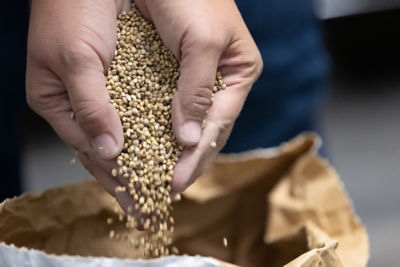Click here to download a PDF version of this spotlight
» Fall or spring are the best times for soil sampling.
» At least every four years soil should be tested for nutrient availability and pH changes.1,2
» Sampling patterns can affect the number of collected soil samples and the precision of soil test results.
» Using global positioning system (GPS) can help map changes in nutrient availability across a field by enabling repeated soil sampling at the same locations.
Timing
The optimum time to test soil is when growing crops have their greatest uptake of nutrients to support plant growth. Since sampling in the summer is often not practical, the timeframes after harvest and prior to fall fertilization or prior to spring fertilization offer an alternative timing. Fall or spring sampling is preferred, since winter sampling may give misleading results due to physical changes in soil from cold winter temperatures.
How Often and How Many
Soil tests are recommended at least every four years. Nutrient availability is highly influenced by environmental conditions, and the seasonal variation should be accounted for when collecting soil samples; especially when comparing soil test results across years. Due to nutrient variability, sampling should occur at the same time of year and following the same crop. Each field or practical management area should be sampled separately. The recommended number of soil samples is a compromise between what is acceptable by the grower from both a cost and precision standpoint. However, the number of samples collected should correspond with capturing variability within the field. Increased field-level variation or intensive management will increase the number of samples required to better explain the relationship of soil test results to crop response.
Recommendations vary for the number of cores taken at each sampling point, ranging from 5 to 7 cores at each point up to 15 to 20 cores.3 The goal is to collect a representative sample at each point. If an area is known to be highly variable from a soil standpoint, then more cores should be taken. Tillage also influences the number of cores required to obtain a representative sample. Due to less mixing and more spatial variation, continual no-till or fields that do not receive tillage on a regular basis will require more cores for each sample (8 to 12) than a field that receives tillage regularly.2 Sampling depth should be taken in accordance with the fertilizer recommendations intended to be used, using a soil probe or a spade. Proportionately more soil cores should be pulled as the area sampled increases.
Sampling Patterns
The sampling pattern impacts the number of samples that will be taken in a field and the precision of soil test results.
 Figure 1. Soil sampling harvest.
Figure 1. Soil sampling harvest.
Whole Field
If a grower chooses to manage the field as a single unit, then a single, representative soil sample should be pulled and analyzed from the field. This method may be the least expensive from a soil sampling and analysis standpoint; however, from a fertilizer cost perspective, it is likely not the most cost-effective.
When collecting this representative sample, collect and composite between 10 and 20 cores for the field. A pattern which accommodates good representation of the area sampled such as a “Z” or “W” pattern is recommended. Sampling should avoid areas that are likely to skew results, such as fertilizer bands, headlands, dead furrows, areas of dust patterns along limestone roads, and areas where stockpiling of composts, manure, or lime have been placed.1,3 The volume of soil collected from these cores will be too large to fit in a sample bag, so collecting the cores in a clean, plastic bucket is recommended. Mix the cores thoroughly before filling the sample bag 1/2 to 2/3 full.
Grid Sampling
Grid sampling uses a systematic approach that divides a field into individual squares or rectangles of equal size, often referred to as “grid cells.” Common grid cell sizes include 2.5-acre, 4-acre, and 8-acre grids. GPS is frequently used to identify precise soil sampling locations.2 Once sampling site locations are identified, a composite soil sample is pulled from within each grid cell and analyzed separately from all other grid cells. Five to seven cores from each grid cell should be collected and composited. Cores may be taken at the center of the grid cell and within 30 feet in each direction from the center of the grid cell. Alternatively, a random collection of cores throughout the grid cell can be taken. Site specific sampling by specific GPS coordinates is intended to help determine changes over time by returning to the same location each time for sampling. Or, GPS coordinates can be used to ensure sampling of different locations, so that a more complete picture of nutrient resources over time is created.
Management Zone Sampling
 Figure 2. Sampling areas based on variation across the field as indicated by differences in soil type and an old fence line.
Figure 2. Sampling areas based on variation across the field as indicated by differences in soil type and an old fence line.
By definition, a management zone is an area that is managed in a similar fashion and differs from other management zones within a field.3 Management zones within a field can be identified by a single or multiple spatial characteristics (Figure 2). Common characteristics include soil type, soil slope, organic matter, yield (production), and soil electrical conductivity. Soil samples are collected at random from within each zone, bulked together, and analyzed to provide an average sample value for each unit.
Handling
Sample cores should be collected in clean plastic containers, mixed, and placed into containers (bags or boxes) designed for soil samples. Be sure to check that all sample tools are not contaminated or were not produced from materials containing elements of interest. For example, zinc-plated soil probes can influence zinc soil test results. Mark the sample so you can identify the field area it came from. Samples can either be sent immediately to a testing facility or left to dry in a dust-free location. Make sure to thoroughly complete the soil information sheet provided by the lab. Information such as cropping history, soil region, and yield goal will be used to calculate recommendations based on the soil sample. Samples can be sent to university testing facilities or to private labs.
Interpreting the Soil Test
Once you have an accurate and comprehensive field assessment from soil sampling, soil testing can be repeated at the same locations to track fertility and pH changes over time. Or, subsequent sampling can be re-defined in order to analyze only representative areas of each field. Another option may be to reduce future sampling to only problem areas.
Variability in soil test results can help explain field variability. By examining the pattern of variability, whether it is pH, phosphorus (P), or potassium (K), a grower can learn more about his field. The patterns of high and low soil property values may be tied to soil type or slope, or the patterns may help explain yield variability. Interpreting the variability in soil test values can take a bit of detective work and it may require looking at past farm records for inputs or recalling how the field was farmed in the past. Coupling prior yield and nutrient application data with soil test results can aid in explaining field variation and also aid in directing future crop management strategies.
Soil is inherently variable, so the more samples that are taken per unit area, the more representative the soil test results will be to crop response. Important information can be obtained by monitoring changes in soil test results over time.
It is important to keep good records on sample locations and test results in order to evaluate the effectiveness of fertilizer programs. For example, if soil tests have been increasing over time, lower rates of fertilizer are the likely management recommendation. Or, if soil test levels are above optimum, then additions of P and K could be omitted for a period of time and levels could be monitored with soil sampling. For consistently low or deficient soil test levels, increased fertilizer rates may be recommended.
In summary, the quality of the sampling methods greatly influences the accuracy of soil test results. An investment in soil testing is an opportunity to make more accurate soil management decisions.
Sources
1 Mallarino, A. and Sawyer, J. Nutrient management: Soil testing. Iowa State University Extension. NMEP 1. Revised September 2003. http://extension.agron.iastate.edu.
2 Hoeft, R. and Peck, T. University of Illinois Agronomy Handbook. Chapter 11: Soil Testing and Fertility. http://extension.cropsci.illinois.edu.
3 Sawyer, J., Mallarino, A., and Killorn, R. Take a good soil sample to help make good decisions. Iowa State University Extension. PM 287. Revised September 2003.
Additional Information
For additional agronomic information, please contact your local seed representative.
Developed in partnership with Technology, Development & Agronomy by Monsanto.
Individual results may vary, and performance may vary from location to location and from year to year. The information provided in this article may not be an indicator of results you may obtain as local growing, soil and weather conditions may vary. Growers should evaluate data from multiple locations and years whenever possible. ALWAYS READ AND FOLLOW PESTICIDE LABEL DIRECTIONS.
Monsanto and the Vine Design® is a registered trademark of Monsanto Technology, LLC. All other trademarks are the property of their respective owners. ©2015 Monsanto Company. 130826060642 092515JEH.
The content of this article should not be substituted for the professional opinion of a producer, grower, agronomist, pathologist and similar professional dealing with this specific crop. SEMINIS DOES NOT WARRANT THE ACCURACY OF ANY INFORMATION OR TECHNICAL ADVICE PROVIDED HEREIN AND DISCLAIMS ALL LIABILITY



